Two days ago I spent 75 minutes near a small, isolated tree in a remote area of northern Utah trying to photograph male Lazuli Buntings at war with each other. It was some of the toughest bird photography I’ve ever attempted.
Four or five males (I never did see a single female) were duking it out by chasing each other around the tree, through the tree and away from the tree and back. I was amazed by the speed and agility of these relatively plump-looking songbirds as one chased another through the air in tight formation. And they kept it up for the entire 75 minutes I was at the tree with only brief breaks to rest.
Occasionally one of them would pause to sing from a favorite perch within the tree but the musical interlude never lasted long and the singing buntings were nearly always at least partially obscured by vegetation so in all that time I only got a few shots I like reasonably well
It was amazing how much fun I had with only limited success.
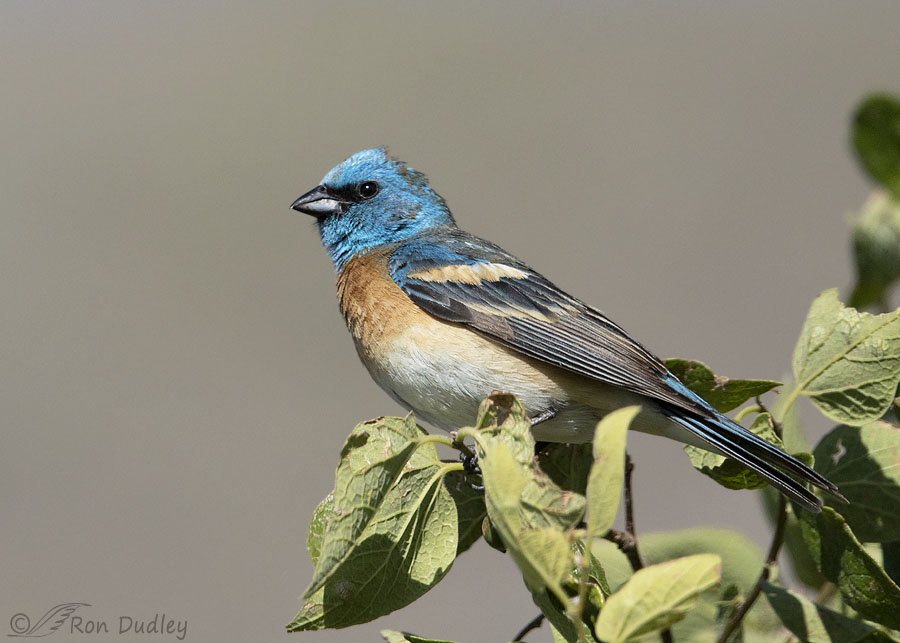
1/6400, f/6.3, ISO 800, Canon 7D Mark II, Canon EF 500mm f/4L IS II USM + EF 1.4 III Extender, not baited, set up or called in
The buntings were beginning to look just a little bit scruffy from molt but their flashy colors were still almost electric to the eye. This is the cleanest background I managed to get in any of my photos of them.
This bird may look relaxed but that’s deceiving. The only reason he’s so exposed on the tree’s periphery is because he’s on the lookout for yet another male rival that he can go after.
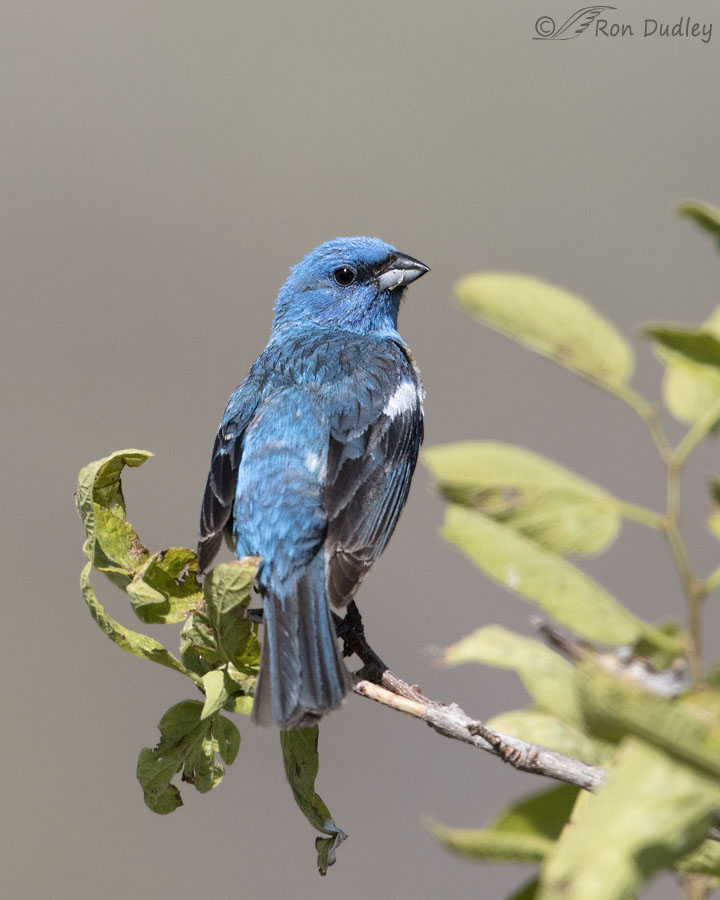
1/5000, f/6.3, ISO 800, Canon 7D Mark II, Canon EF 500mm f/4L IS II USM + EF 1.4 III Extender, not baited, set up or called in
This guy is doing the same thing – looking for rivals to pursue. In order to get a better look through the tree on his right he…
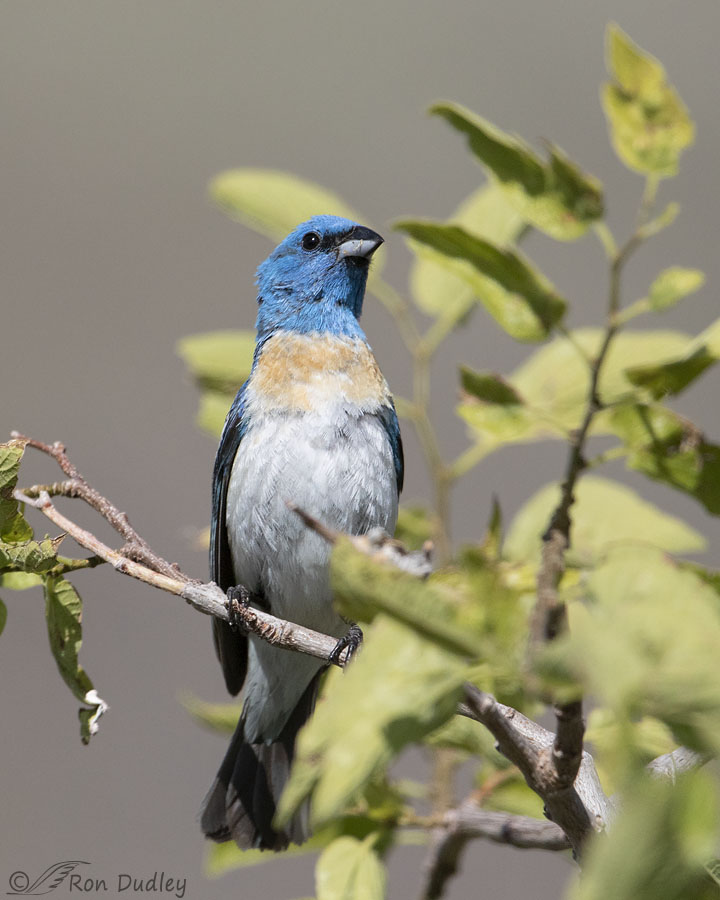
1/5000, f/6.3, ISO 800, Canon 7D Mark II, Canon EF 500mm f/4L IS II USM + EF 1.4 III Extender, not baited, set up or called in
turned on his perch and assumed this stretched-out pose so he could see over and through all the leaves as he looked for other buntings in the tree to chase after. They seldom had to wait long before they got another male in their crosshairs.
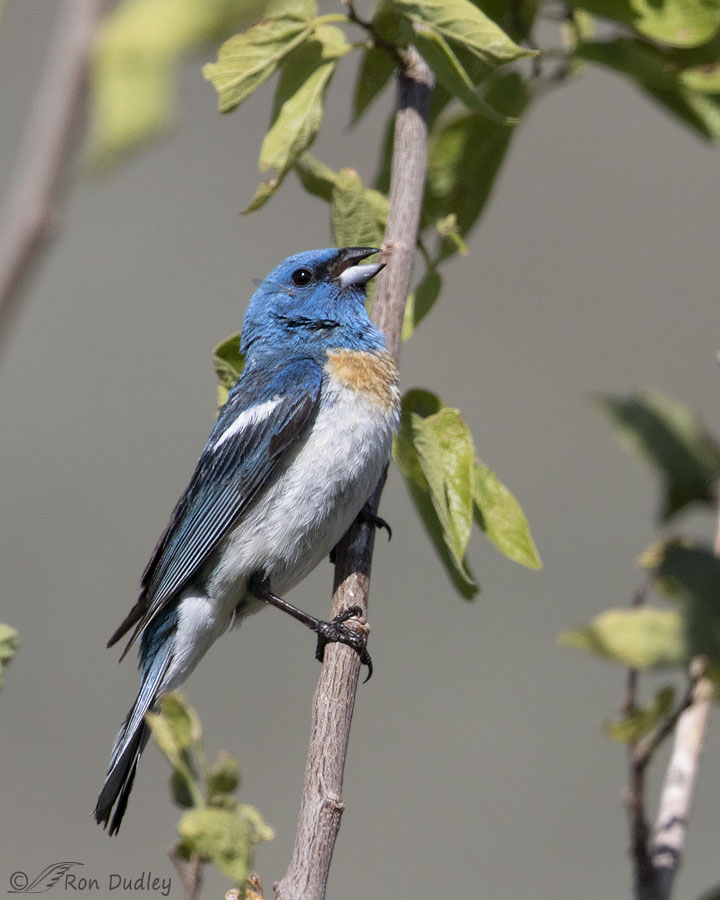
1/6400, f/6.3, ISO 800, Canon 7D Mark II, Canon EF 500mm f/4L IS II USM + EF 1.4 III Extender, not baited, set up or called in
I believe this was the most dominant male in the bunch. He had two favorite singing perches, both of them vertical branches within the tree that almost never allowed me a clean shot despite repeatedly maneuvering my pickup for the best shooting angles I could get.
So, how did I keep track of the individual bird that I thought was the most dominant one given the fact that all of the males looked nearly identical? Check out the ‘object’ stuck to his plumage directly behind his right eye.
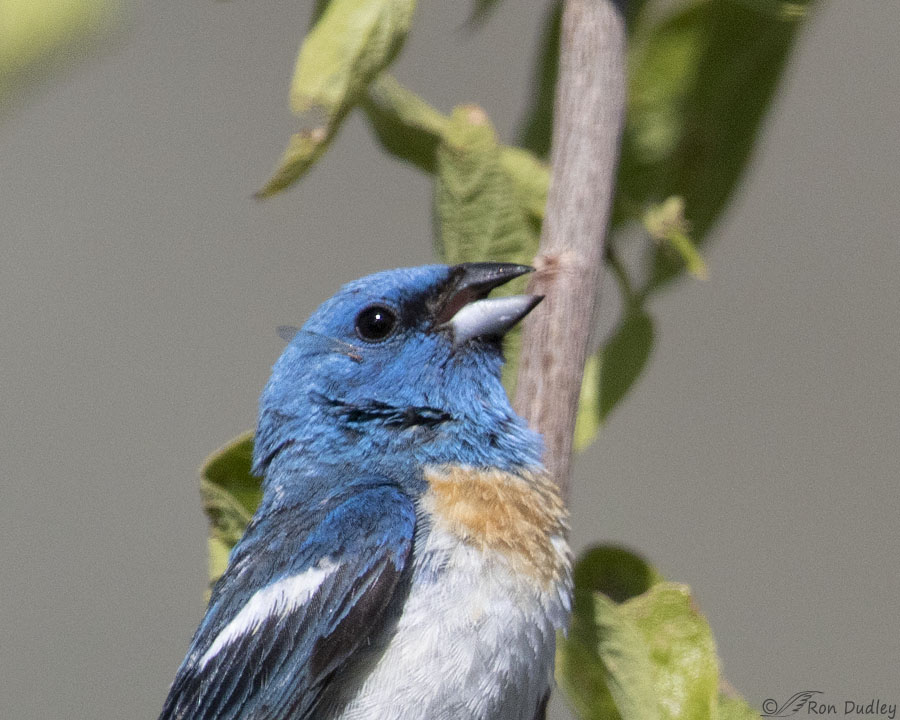
It’s an insect wing and it was stuck to the side of his face for the entire time I was at the tree. Apparently preening and cleaning his plumage was the last thing on his mind with all those other males to chase after. Lazuli Buntings are primarily seed and fruit eaters through most of the year but they eat insects and other arthropods during the breeding season.
This photo also gives us a good look at the bicolored bill of Lazuli Buntings – the upper mandible is black while the lower mandible is a very light blue, often appearing white. I’ve found that bright lower mandible to be problematic for photography because it often produces annoying specular highlights (very bright light reflections).
So all in all it was an exciting morning with the buntings even though my photographic results didn’t quite meet my expectations. As a bonus I got in some valuable practice following quick and elusive birds with my lens and I learned a great deal about their behavior.
Right up my alley.
Ron


I’m a tad late, but I agree with Patty! I have to say from the standpoint of my first viewing of this species to seeing a couple of other times during our travels out West, this is my favorite bird.
Beautiful shots!
Just how beautiful can you get?
Wow. And wow again.
I am not sure whether their antics or trying to keep up with their antics would be more exhausting.
I am very grateful you persevered. And that at least occasionally they scheduled rest-breaks/reconaissance in clear(er) view.
It was exhausting just to watch them, EC. They were going full-bore for so much of the time I I had to wonder how they got that much energy.
Gorgeous!!!
Thanks, Arwen.
Ron, these are beautiful photos. I did not know they would stick around for breeding at that elevation. I thought they went higher. For now it is a great spot, secluded, water, lots of insects.
April, I didn’t see a single female. Females could still be at the nest but I wondered if these males were through breeding already.
They’re such striking birds — like bluebirds on steroids with their turquoise heads and backs as well as that rust upper chest. I think the light blue mandible is most apparent in the second shot. He also has some leftovers along for the ride.
BTW, today is National Onion Rings Day and National Chocolate Eclairs Day. You’re welcome.
Not a food combination which tempts me.
Bluebirds on steroids, I like that.
I’m a sucker for just about anything chocolate but eclairs aren’t at the top of my list. I have a friend who is dying to try chocolate covered bacon but I think I’d prefer the chocolate for dessert.
I don’t eat them often, but eclairs have a special place in my heart. My grandmother made eclairs and other things with pat a choux pastry. I remember helping her in the kitchen when I was a little girl.
Chocolate covered bacon isn’t that great, in my experience. Now bacon cooked in the oven with a little brown sugar sprinkled over it (in or out of a BLT) is another thing altogether!
What a wonderful series Ron! Thanks for sharing!
Thanks, Charlotte.
As your last several blogs are proven, I really need to get out more–a LOT more. I don’t think I’ve ever seen a bunting before. Part of the issue is I can’t handle binoculars any better than I can handle a camera, so I’m at a big disadvantage. Another part is when I’m out with the hawks, I really need to pay most of my attention to them because they’re amazingly fast, too.
So again, thank you for bringing this outrageous beauty to me!
Yes, the molt is a stressful time, and birds sometimes look ragged, but oddly, it doesn’t last that long. A good preen and they’re back to their gorgeous selves until the next bunch of feathers go. Wish I could do that, but no. Not happening with me!
I’m not very good with binoculars either, Laura – that’s a skill that needs to be developed and with my big lens I generally don’t have a need for it.
Terrific series, Ron!
Another bird I may never see. They seldom show up here in migration.
They seldom show up here in migration.
Nice work on remembering to take a few photographs! I might have been so enthralled watching their antics I’d have forgotten I had a camera.
Ha, it’s pretty hard to forget with that big lens in my hands, Wally.
But I’ll admit there were times when I put it down and just watched them chasing each other at blazing speeds – there’s no way I could have seen that through my lens because they were impossible to follow in flight.
I’m trying to figure out why these photos didn’t quite meet your expectations. ;)
;)
As Jean says, the colors are vivid;
eye catches in every photo;
bird in habitat;
various postures and angles;
possible evidence of diet (the wing);
no overexposure of lower bill or white feathers that I can see.
attention to detail affording individual ID, again via insect wing;
I imagine the focusing was quite a challenge, what with the near constant movement and the surrounding foliage;
interesting behavioral narrative, though I wasn’t aware they ate oats
Yep, I can see why you’d be a bit disappointed.
“I’m trying to figure out why these photos didn’t quite meet your expectations”
Lyle, when I spend that much time with that many birds up close I normally expect to get many more than just a handful of shots that I like and I should get a few extraordinary ones.
But these guys were just too fast, frantic and elusive for that. I like some of the shots I got pretty well but overall I expected, or at least hoped for, more. And better.
We had a vagrant last summer. All the local birders raced down to a shutdown mill site to see him. He was worth the effort and then some. Life bird for me.
Glad you ‘got’ him, Catherine.
I’m so glad you “got” some of them–your photos made my morning bright ! Ten years or so ago
in Prescott , I happened to look out my window, and a flock–maybe 15 or
so male Lazuli Buntings were on the ground cleaning up spilled birdseed
from a feeder–they must have been migrating–there were no females in
the flock. I never saw them again, but their truly turquoise color glows
in my memory to this day!
Wow, 15 male Lazuli’s at one time. I thought I was doing well with 4 or 5.
WOW! Scruffy or not they ARE beautiful! Does sound like fun even if a lot of work and, I’m sure, frustrating at times…….
Does sound like fun even if a lot of work and, I’m sure, frustrating at times…….  The lower bill being so light compared to the upper is interesting and, I’m sure it was a challenge photography wise as high contrast situations can be….
The lower bill being so light compared to the upper is interesting and, I’m sure it was a challenge photography wise as high contrast situations can be….
5 Pelicans on the creek at day break this morning. 3 a few days back feeding along the far side – VERY unusual BUT fun to watch and learn about.
I hope you continue to have fun with your pelicans, Judy.
Thanks for letting us peek down your alley!
You’re very welcome, Mary.
What colorful birds they are. We have them here, but I rarely find them and when I do they have been very difficult to photograph. The colors are so vibrant they grab your full attention and I have to admit that I never realized they had a bi-colored beak till you mentioned it here. Thank you. Excellent photos Ron.
Everett, I can’t tell you how many of my otherwise nice photos of them are pretty much ruined by the intense light reflection off of their lower mandible.
The blue is so vivid. Love the pics!
Thanks, Jean.
Wonderful photographs and wonderful birds! Another one of the birds I’d like to catch a look at when I make it out West!
Thank you, Joanne.